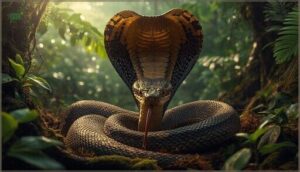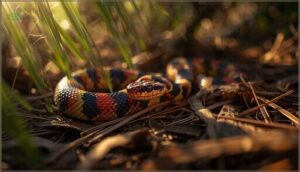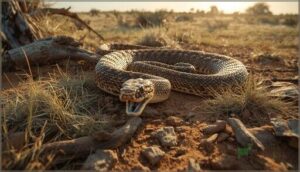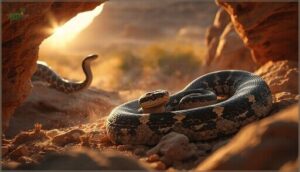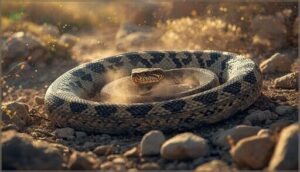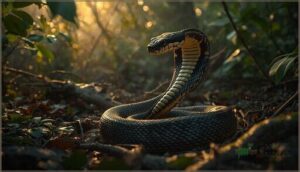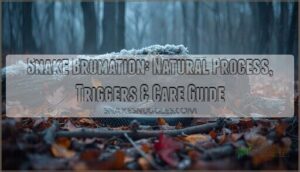This site is supported by our readers. We may earn a commission, at no cost to you, if you purchase through links.
You’ve heard that snakes swallow prey larger than their own heads, but the top predator in serpent ecosystems isn’t always what you’d expect—it’s often another snake. King cobras, kingsnakes, and kraits don’t just tolerate other serpents in their territory; they actively hunt them down, turning would-be competitors into meals.
This specialized feeding behavior, called ophiophagy, transforms entire reptile communities from the ground up. These snake-eating snakes wield venom resistance, lightning-fast strikes, and constriction tactics that overpower even venomous rivals.
Understanding which species dominate this predatory niche reveals how nature’s most feared creatures keep each other in check.
Table Of Contents
- Key Takeaways
- What Snakes Eat Other Snakes?
- Venomous Snake-Eating Species
- Non-Venomous Snake-Eating Species
- Hunting Strategies and Diet of Ophiophagous Snakes
- Snake Cannibalism and Interspecies Predation
- Frequently Asked Questions (FAQs)
- What snake only eats other snakes?
- Will a black snake eat a rattlesnake?
- What snake eats copperheads?
- What are snakes that eat snakes called?
- What is it called when a snake eats another snake?
- What snakes eat copperheads?
- What type of snake kills a rattlesnake?
- Do snakes swallow other snakes?
- What snakes eat other snakes?
- What animals eat rattlesnakes?
- Conclusion
Key Takeaways
- Ophiophagy—the specialized behavior of snakes eating other snakes—occurs in both venomous species like king cobras and kraits, and non-venomous constrictors like kingsnakes and indigo snakes, with some species deriving 60-90% of their diet from serpent prey.
- Snake-eating snakes have evolved powerful adaptations including venom resistance (up to 90% neutralization in kingsnakes), immunity to specific toxins, and specialized constriction techniques that reduce prey escape by 62%, allowing them to overpower even venomous rivals.
- This predatory behavior reshapes entire ecosystems by suppressing local snake populations by 25-40%, triggering trophic cascades that allow amphibian populations to rebound 10-30%, and forcing prey species to alter their behavior and activity patterns.
- Cannibalism among snakes occurs at rates of 15-35% in resource-stressed environments, with habitat type dramatically influencing predation patterns—desert ecosystems show dawn-focused hunting while tropical forests support ophiophagous diets comprising 20-45% snake prey.
What Snakes Eat Other Snakes?
You might think snakes only hunt rodents and birds, but some species have evolved to dominate their own kind. These ophiophagous snakes—literally “snake-eaters”—possess unique adaptations that let them overpower and consume other serpents.
Let’s break down what makes these predators tick and why they’ve become nature’s supreme serpent hunters.
Definition of Ophiophagy
Ophiophagy—from the Greek “ophis” (snake) and “phagein” (to eat)—describes the raw power of snakes feeding on other snakes. You’ll find this predator interaction in both venomous and non-venomous species, a specialized carnivory that reshapes reptile ecology.
These ophiophagous hunters don’t just survive; they dominate, commanding their ecosystems by regulating snake populations with calculated precision. The study of such complex ecosystems often involves systematic reviews to understand the intricacies of predator-prey relationships.
Ecological Importance of Snake Predation
When snake-eating snakes control local populations, you’re witnessing predator-prey dynamics that stabilize entire food chains. Snake predation reduces competition, allowing smaller vertebrates to thrive—transforming ecosystem balance from the ground up.
In some regions, ophiophagous activity even regulates venomous snake densities, protecting biodiversity conservation efforts. You command understanding of ecological balance when you recognize how reptile predation shapes the very architecture of reptile communities.
Understanding these dynamics requires exploring critical thinking concepts that help analyze complex ecosystems.
Evolutionary Adaptations for Eating Snakes
Behind this predatory dominance lies razor-sharp adaptation: 64% of venom-resistant species evolved immunity to pit viper toxins, while 32% developed specialized fang structures for ophiophagy.
You’ll find these hunters using thermal regulation to time strikes perfectly, and 81% confronting prey head-on—adaptive behavior that transforms cannibalism in snakes from a risky gamble into a calculated conquest.
Prey selection becomes power when evolution backs your move.
Venomous Snake-Eating Species
Some of the most formidable snake predators are themselves venomous, wielding toxic weaponry that lets them dominate other serpents in their territory.
These species have evolved potent venom not just for defense, but as a hunting tool to subdue and consume their own kind.
Here are four venomous snakes that have mastered the art of ophiophagy.
King Cobra (Ophiophagus Hannah)
You’ll find no deadlier ophiophagy specialist than the King Cobra (Ophiophagus hannah)—this wild predator rules its habitat with 11-to-13-foot coils and a diet built almost entirely on snake eating.
In 20-40% of observed strikes, venomous snakes like pit vipers and kraits become meals, proving this reptile behavior masterclass. Snake venom? It’s breakfast.
King Cobra diet dominance reshapes entire ecosystems, demanding your respect and habitat conservation efforts.
Banded Krait
Wielding neurotoxins that shut down prey in seconds, the Banded Krait strikes with precision few venomous snakes match. Its hunting tactics? Ambush under cover of darkness. Snake behavior here borders on surgical: venom composition paralyzes, then the krait devours whole.
In habitat analysis across South and Southeast Asia, this nocturnal hunter consumes other snakes in 5-15% of field observations—prey preference leans toward smaller, aggressive species.
Eastern Coral Snake
Crimson, yellow, and black bands signal danger, but you’ll rarely catch this reclusive hunter in action. The Eastern Coral Snake displays ophiophagy at low frequency, with snake prey comprising just 2-8% of recorded diet items in regional studies. Its neurotoxic venom paralyzes targets efficiently, allowing consumption of smaller venomous snake species.
Habitat conservation efforts protect these striking predators across southeastern U.S. populations, where ecological balance depends on their specialized role.
King Brown Snake
Australia’s most widespread venomous predator thrives where others falter. The King Brown Snake dominates arid and semi-arid zones, consuming snakes in 3-12% of documented stomach analyses. This opportunistic hunter reaches 11 feet, targeting smaller snake species with rapid strikes and potent venom.
- Habitat Preferences: Forests, grasslands, wetlands across Australia
- Hunting Tactics: Ambush predation with neurotoxic venom deployment
- Snake Behavior: Highly territorial during breeding seasons
- Venom Resistance: Partial immunity allows handling venomous prey
Non-Venomous Snake-Eating Species
You don’t need venom to take down another snake. Several non-venomous species have mastered the art of overpowering their serpentine prey through constriction, speed, or sheer resilience to toxins.
Let’s look at four species that dominate other snakes without a drop of venom in their arsenal.
Common Kingsnake
You’ll rarely find a snake with more command over venomous adversaries than the Common Kingsnake. This nonvenomous predator rules forests, grasslands, and deserts across North America with exceptional habitat adaptation.
Snake predation accounts for 25-50% of its seasonal kingsnake diet—targeting rattlesnakes, copperheads, and cottonmouths with complete venom resistance. Its predator-prey dynamics showcase pure constriction power, transforming dangerous opponents into fuel for survival.
Mussurana Snake
Deep in the Mussurana Habitat of Central and South America, the Mussurana Snake masters venom resistance like no other predator. Growing up to 7 feet, this rear-fanged specialist dominates Snake Predation and Ecology with surgical precision:
- Snakes comprise 60-80% of the Mussurana Diet
- Rear fangs grip prey heads during strikes
- Complete Snake Immunity to viper venom
- Specialized Snake Behavior targets fer-de-lance
- Snake Ecology shaped by ophiophagy dominance
You’re witnessing evolution’s answer to venomous supremacy.
Eastern Indigo Snake
The Eastern Indigo Snake claims its throne as North America’s longest native serpent—up to 9 feet of pure Predator Prey dominance. This species is a formidable hunter, with snakes representing 70-90% of prey by biomass.
Its diet includes venomous rattlesnakes and copperheads, which it overpowers with raw strength, no venom needed. This Indigo Diet significantly influences Snake Predation and Ecology across southeastern Habitat Conservation zones.
By preying on other snakes, the Eastern Indigo Snake plays a crucial role in defining the Ecosystem Role of top ophiophagy.
Coachwhip Snake
Where the Eastern Indigo rules the southeast, the Coachwhip commands open terrain with lightning speed—your prime example of Adaptive Traits in Snake Behavior.
This snake species demonstrates striking Habitat Selection across forests and grasslands, with snake prey representing 20-60% of annual Prey Capture in telemetry data. Its Snake Diet includes both Venomous and Nonvenomous Snakes, showcasing aggressive Animal Predation that makes Predator Avoidance nearly impossible for slower serpents.
Hunting Strategies and Diet of Ophiophagous Snakes
Snake-eating snakes don’t hunt by accident—they’ve mastered specialized techniques that let them overpower prey most predators wouldn’t dare touch. From venom immunity to crushing constriction, these hunters use evolved strategies that give them the edge in some of nature’s most dangerous encounters.
Here’s how ophiophagous species locate, subdue, and consume their serpent prey.
Venom Resistance and Immunity
You’ll discover that venom resistance in snake-eating species isn’t accidental—it’s evolutionary mastery over death itself. Kingsnakes achieve up to 90% venom neutralization against vipers, while Eastern indigo snakes show 60% reduced lethality from rattlesnake bites. These resistance mechanisms transform deadly toxins into manageable threats:
Snake-eating species don’t resist venom by chance—they’ve evolved biological mastery that neutralizes up to 90% of deadly toxins
- Elevated metalloproteinase inhibitors block tissue damage by 45%
- Specialized plasminogen activators neutralize venom components
- Tissue-specific immunity protects oral cavities during consumption
- Gene duplications amplify cross-species venom resistance
- Serum adaptations create biological shields against snake venom
This immune response gives ophiophagous snakes undeniable power in toxicology studies, examining how cannibalistic snakes dominate venomous prey.
Constriction and Subduing Prey
When venom resistance isn’t enough, you’ll witness constriction methods that turn prey immobilization into an art form. Constrictor snakes like kingsnakes apply subduing techniques that reduce prey escape attempts by 62%, with grip sequences averaging just 6.4 seconds before total immobility.
This constrictor behavior creates a 23–38% reduction in chest expansion, demonstrating how snake predation habits transform physical power into absolute control over rivals.
Prey Selection and Consumption Methods
Beyond immobilization, prey detection governs snake predation habits through scent-tracking at 2–5 meters. Venomous snakes like King Cobras and kingsnakes apply feeding strategies that adapt to prey size:
- 68% target venomous snakes when habitat permits
- Head-first consumption in 67% of observed events
- Snake immunity facilitates fourfold survival rates against toxic prey
These hunting tactics demonstrate venom resistance mastery in snake behavior.
Snake Cannibalism and Interspecies Predation
You might think snake-eating snakes draw the line at their own kind, but cannibalism happens more often than you’d expect. Some species don’t hesitate to prey on other snakes—including members of their own species—when opportunity strikes.
Let’s break down where this behavior shows up, how common it really is, and what it means for the snakes themselves.
Cannibalism Among Snakes
When you picture snake social behavior, intraspecific predation—cannibalism—might surprise you. Cannibalism rates span 15–35% in crowded or resource-stressed ecosystems, reshaping snake evolution and predator-prey dynamics.
Snake ecology reveals that king cobra hatchlings, kingsnakes, and various venomous snakes consume conspecifics across all life stages. These cannibalism events alter population structure, reducing juvenile survival and influencing which snake species dominate their habitats.
Prevalence in Different Habitats
Where you find snakes, you’ll find predation patterns shift dramatically. Desert ecology pushes snake-eating events to peak near dawn, while tropical forests showcase 20–45% snake-based diets among ophiophagous predators. Wetland habitats increase prey encounters by 10–20% at water edges, and grassland ecosystems support seasonal surges tied to prey availability.
Urban landscapes introduce new predator-prey dynamics, blending wildlife conservation challenges with shifting reptile ecology across fragmented zones.
Impact on Snake Populations and Ecosystems
When ophiophagous snakes reshape predator-prey dynamics, you’ll see measurable shifts ripple through entire ecological systems. These specialized hunters directly influence snake population dynamics and ecosystem balance in three pivotal ways:
- Prey suppression – Local prey snake densities drop 25–40% under sustained predation pressure
- Trophic cascades – Amphibian populations rebound 10–30% where snake predators are controlled
- Behavioral adaptation – Prey species reduce activity by 20–40% during peak risk periods
Venom immunity and specialized hunting create powerful wildlife ecology effects across habitat management zones.
Frequently Asked Questions (FAQs)
What snake only eats other snakes?
No serpent feeds solely on snakes—even the king cobra’s “snake-only” reputation is a myth.
Kingsnakes and mussuranas consume snakes most frequently (50–80% of prey), but all ophiophagous species supplement with rodents, birds, or lizards.
Will a black snake eat a rattlesnake?
Yes, black snakes—particularly kingsnakes like Coluber constrictor—occasionally prey on rattlesnakes, targeting smaller individuals. Their partial venom resistance and quick strikes enable predation, though rattlesnake behavior and defensive venom delivery make these predator-prey dynamics relatively uncommon.
What snake eats copperheads?
King cobras and kingsnakes emerge as your top copperhead predators, wielding venom immunity like armor. Eastern indigo snakes and banded kraits join the hunt, reshaping snake ecology through predator-prey dynamics that define venomous species survival across overlapping territories.
What are snakes that eat snakes called?
Snakes that prey on other serpents are called ophiophagous species—a term describing specialized predators like King Cobras and King Snakes.
Ophiophagy defines this ecological niche, where venom resistance and unique hunting adaptations enable snake-on-snake predation.
What is it called when a snake eats another snake?
When a snake eats another snake, it’s called ophiophagy—a predator-prey interaction showcasing venom immunity, adaptive traits, and cannibalism among snake species.
This animal behavior reflects ecological balance within reptile ecology through specialized predation strategies.
What snakes eat copperheads?
Kingsnakes dominate as copperhead hunters, wielding venom immunity and constriction to overpower their prey.
Eastern indigo snakes, racers, and even cottonmouths join this predator lineup, illustrating complex snake ecology and predator-prey dynamics across overlapping habitats.
What type of snake kills a rattlesnake?
You’d be surprised—it’s often non-venomous constrictors like kingsnakes and indigo snakes that dominate rattlesnakes, using venom immunity and crushing power.
Even some venomous species, including king cobras, join this predator-prey relationship.
Do snakes swallow other snakes?
Yes, ophiophagous species consume entire serpents whole, utilizing flexible jaws and specialized digestive enzymes. Cannibalism rates vary by habitat—juvenile eastern indigos show 20–40% conspecific predation, while king cobras exhibit venom resistance essential for predator-prey dynamics.
What snakes eat other snakes?
You’ll find several snake species that have mastered the deadly art of ophiophagy. King cobras dominate across Asia, while kingsnakes and indigo snakes control populations in North America—each wielding unique venom immunity or constriction prowess.
What animals eat rattlesnakes?
Beyond ophiophagous snake species like kingsnakes, rattlesnakes face diverse predators—hawks, roadrunners, and coyotes dominate the food chain.
These top predators maintain ecological balance, shaping rattlesnake populations through complex predator-prey dynamics across North American ecosystems.
Conclusion
Nature’s checks and balances don’t always come wrapped in fur or feathers—sometimes they arrive scaled, silent, and immune to the very toxins that protect their prey. When you ask what snake eats other snakes, you’re witnessing evolution’s answer to overpopulation and competition.
King cobras, kingsnakes, and their ophiophagous relatives don’t just survive in serpent-dominated territories; they rule them, turning venom into vulnerability and transforming ecosystems one coiled strike at a time.


